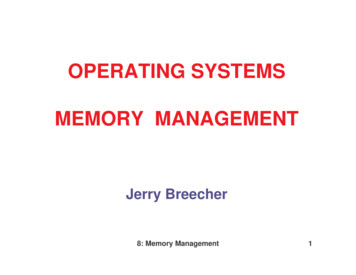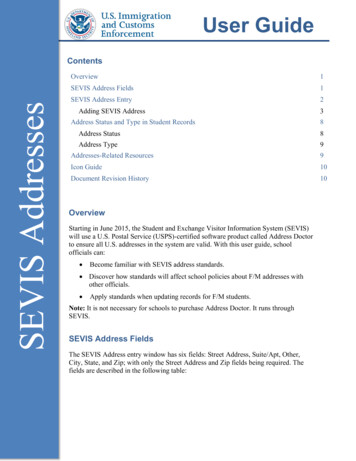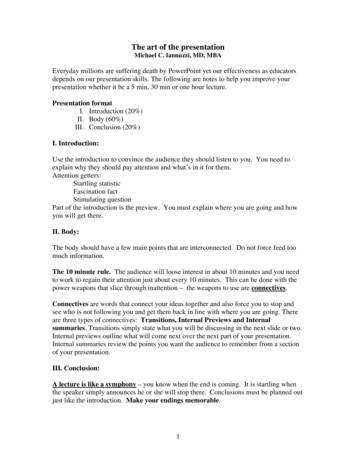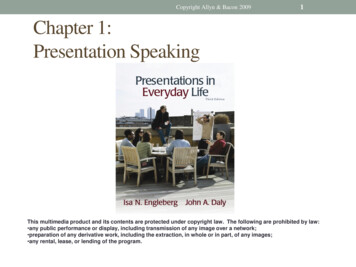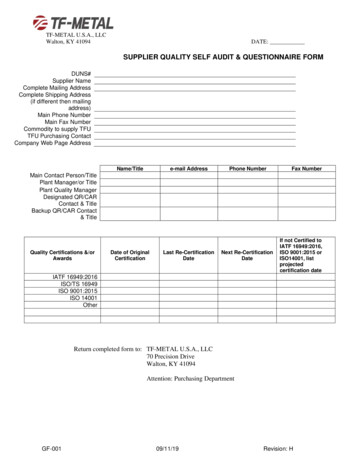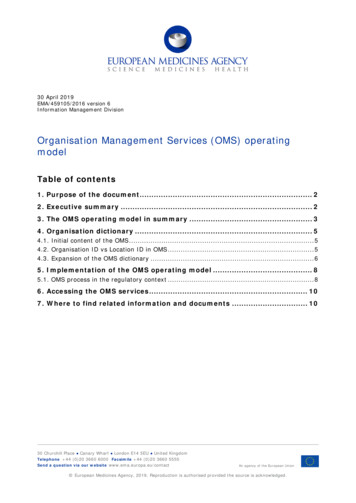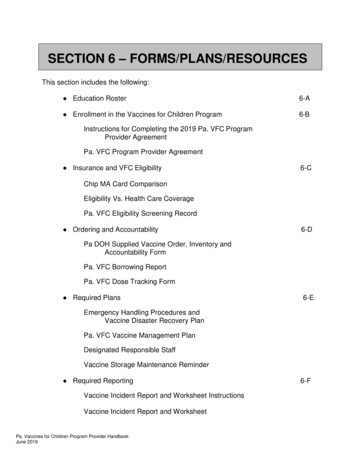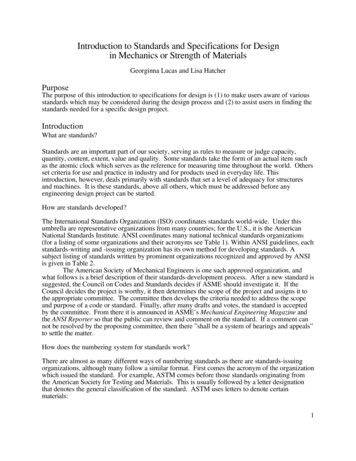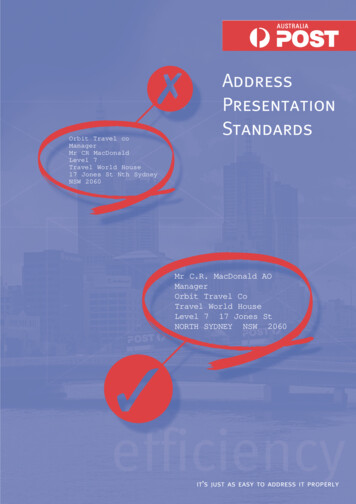
Transcription
AddressPresentationStandardsOrbit Travel coManagerMr CR MacDonaldLevel 7Travel World House17 Jones St Nth SydneyNSW 2060Mr C.R. MacDonald AOManagerOrbit Travel CoTravel World HouseLevel 7 17 Jones StNORTH SYDNEY NSW 2060it’s just as easy to address it properly
Table of Contents1Introduction2General Guidelines for Machine Printing Addresses3Address Presentation Standards1. Addressee Reference Number/Type62. Person Title73. Given Name84. Family Name95. Orders, Decorations and Distinctions106. Job Function Title117. Organisation Name128. Building/Property Name139. Building/Complex Sub Unit1410. Floor/Level1611. House/Property Number1812. Lot/Section Number1913. Street Name and Type2014. Postal Delivery Type2215. Placename/Suburb/Locality2316. State/Territory2417. Postcode2618. Country of Destination28Typical Sample Addresses29
2IntroductionCurrently OCR’s used by Australia Post read the placename, State, postcode and other keywords frommachine-addressed letters, and only the postcode from hand-addressed letters that has the postcodeprinted in the Postcode Squares. So until now Australia Post has essentially concentrated on encouragingthe correct formatting of the last line of the address.Australia Post is now introducing advanced letter sorting equipment which incorporates new multi-lineOCRs (MLOCR). These new machines are able to read full address information, which will allow lettersto be sorted to a finer level. To enable the MLOCRs to perform at high levels of efficiency, all lines of theaddress should be formatted correctly and in a consistant manner.The following standard outlines the correct format for addresses to be presented on letters, or the wayin which address information is placed on envelopes. The standard has been based on two address datastorage standards:" Australian Standard AS4212-1994 - “Geographic Information Systems - Data dictionary for transferof street addressing information”; and," Australian Standard AS4590-1999 “Interchange of Client Information”.All abbreviations used in this document are based on Australian Standard AS4590-1999. The AddressPresentation Standards do not contain a complete list of abbreviations, only those commonly used. Fora more extensive list of abbreviations please refer to the Australian Standards document.These presentation standards should be read in conjunction with Australia Post’s Correct AddressingGuidelines and Australia Post’s Customer Barcoding specification (Specification Number 2034-State Barcodes).Whilst these standards have been specifically developed for the machine addressing of small lettersit is recommended that they apply to all categories of mail, including hand addressing mail items.it’s just aseasy to addressit properly
Guidelines for machine printing addressesGenerally, the MLOCR can read most typed and printed upper and lower case letters and numerals,provided that the type is clear and sharp and the characters do not touch or overlap.Australia Post prefers upper case printing to be used.Black print is preferred, however dark colours are acceptable.All lines of the address must be left justified.Size.Individual characters should have a minimum height of 1.8mm and a maximum height of 7.0mm,however ideally the print characters should be between 2.0mm and 4.0mm. The width of each charactershould be no less than 0.3mm and no more than 7.0mm.Consistency of Character Size.Each line of the address should contain characters of the same size and typeface.Gaps between Characters.There should be a clear gap of at least 0.3mm between characters. Character density or pitch of10,11,12 or 14 characters per inch is preferred. Bolding of characters can sometimes cause characters totouch and therefore this procedure is not recommended when addressing.Gaps between Lines.Gaps between lines should be uniform between all address block lines, with a minimum betweensuccessive lines of 1.0mm and a maximum of 2.5mm.Length of Lines.A maximum of 40 characters in any line in the address, including spaces between words, is acceptable,i.e. lines must not contain more than 40 characters.3
4Print Font.Australia Post prefers addresses to be printed in a fixed pitch font, for example Courier (12 point,10 pitch) or OCR (B). However, if proportional fonts are used, for example, Helvetica, the print charactersmust not touch or overlap.Punctuation in Address.Punctuation in the address proper should be avoided. Punctuation in the “name line” and the useof - and / to separate defined address elements is acceptable.Correct Addressing.For specific information on correct addressing, including colours, envelope requirements, window panelrequirements, hand-addressing requirements etc., please refer to Australia Post Correct AddressingGuidelines and the appropriate section of the Letter Post and Electronic Mail Post Guide.Customer Barcoding.For specific requirements on printing customer barcodes on letters please refer to Australia PostSpecification 203, titled 4-State Barcodes.
Address presentation standards"The following Address Presentation Standards areprovided in the order that such address elementsshould appear on letters."The sub-heading “Usage” after each standard depictsa sample address increasing, with each particularaddress element being added. The particular addresselement has been highlighted in red.5
61. Addressee reference number/typeDefinition:An organisation or company may allocate a reference number to identify a particular addresseeor subject matter. This information is usually depicted in alpha or numeric format, or a mixture of both.Requirement:As this information is not considered part of an address its use is optional.Position within Address:This data does not form part of address information, however, if a reference number is requiredto appear with address data it should be located as the first item on the top line, and must beleft justified.Format/Presentation:Can be printed in either upper or lower case, or a mixture of both.Examples:1234567890DS46789Ait’s just aseasy to addressit properly
2. Person title7Definition:A descriptor used before a persons name or title, usually depicted in abbreviated form.Requirement:Considered a preferred element of an address.Position within Address:The Person Title is the first item, positioned before the Given Name, located on the top line or“Attention” line in an address. The “Attention” line of an address is normally located above the last twolines of the address. See example on Page 29.Format/Presentation:Ideally printed in upper case, however upper case for the first character and lower case for subsequentcharacters, is acceptable.It is recommended that this element be abbreviated.Abbreviations:Person rendRevUsage:1234567890MR C.R. MACDONALD1234567890Mr C.R. MacDonald
83. Given nameDefinition:A name given to the addressee also referred to as Christian name or first name. This informationis usually depicted by initials, however this is not a requirement.Requirement:Considered an essential element of an address.Position within Address:The Given Name is positioned after the Person Title, located on the top line or “Attention” linein an address.Format/Presentation:If initial/s are used they should be printed in upper case. Full stops can be used to separate initials,if required. If the full name is used it should ideally be printed in upper case, however upper case forthe first character, and lower case for subsequent characters in the name is acceptable. It is alsoacceptable to mix a given name in full with initials, i.e. Robert J.Examples:CHRISTOPHER ROBERTChrisMary-AnneRobert J.ABC.R.CUsage:1234567890MR C.R. MACDONALD1234567890Mr C.R. MacDonald
4. Family name9Definition:The family name of the addressee also referred to as last name and surname. This information shouldnot be abbreviated, unless the abbreviation is based on common acceptance.Requirement:Considered an essential element of an address.Position within Address:The Family Name is positioned after the Given Name, located on the top line or “Attention” linein an address.Format/Presentation:Ideally printed in upper case, however upper case for the first character and lower case for subsequentcharacters in each name, is acceptable. Dual family names should be separated by a hyphen ( - ).Examples:MacDonaldSmithO’CALLAGHANde LucyWatson-JonesUsage:1234567890MR C.R. MACDONALD1234567890Mr C.R. MacDonaldit’s just aseasy to addressit properly
105. Orders, decorations and distinctions.Definition:Honours, awards, qualifications and other identifiers conferred on the addressee.Requirement:Considered an optional element in an address.Position within Address:Orders, Decorations and Distinctions are positioned after the Family Name, located on the top lineor “Attention” line of an address.Format/Presentation:Printed in upper case, however upper case for the first character, and lower case for subsequentcharacters of each word, based on common usage, is acceptable.It is recommended that this element be abbreviated.Abbreviations:Order, Decoration or DistinctionAbbrevBachelor of ArtsBAMember of ParliamentMPMember of the Institution of Engineers, AustraliaMIEAustOfficer of the Order of AustraliaAOUsage:1234567890MR C.R. MACDONALD AOit’s just aseasy to addressit properly1234567890Mr C.R. MacDonald AO
6. Job/function title11Definition:A direction to a nominated person, position or section in an organisation. It can also be usedto indicate the addressee’s job or function. Usually expressed in full, however can be depictedin an abbreviated form.Requirement:Considered an optional element of an address, when used with addressees name. If no name is usedin address, this element would be deemed as essential.Position within Address:The Job Function Title is positioned on a separate line, generally located on the top line or “Attention”line in an address. However, on occasions where the addressee’s name is used, it should be locatedon the line below the addressees name.Format/Presentation:Ideally printed in upper case, however upper case for the first character and lower case for subsequentcharacters of each word, is acceptable.Examples:MANAGING DIRECTORSales ManagerCEOManagerFINANCE DEPARTMENTUsage:1234567890MR C.R. MACDONALD AOMANAGER1234567890Mr C.R. MacDonald AOManager
127. Organisation nameDefinition:Full name of the organisation/firm/company/trading name as normally recognised or traded under.Abbreviations can be used but should be based on common usage/acceptance.Requirement:Considered an essential element of an address, in circumstances where mail is addressed to a company.Position within Address:The Organisation Name is positioned on a separate line, located on the top line of an address. It alsocan be positioned under the addressees name or Job Function Title.Format/Presentation:Ideally printed in upper case, however upper case for the first character and lower case for subsequentcharacters of each word, is acceptable.It is recommended that the Organisation Name type be abbreviated as per the table set out below.Abbreviations:Organisation NameAbbrevOrganisation NameAbbrevCompanyCONo Proprietary LimitedPty LtdExamples:ORBIT TRAVEL COShe Boutique IncBHP Rail Products Pty LtdUsage:1234567890MR C.R. MACDONALD AOMANAGERORBIT TRAVEL CO1234567890Mr C.R. MacDonald AOManagerOrbit Travel Co
8. Building/property name13Definition:The full name used to identify the physical building or property. Usually this information is notabbreviated. Should include any reference to a wing or other components of a building complex,if applicable.Requirement:Considered an optional element of an address, however in certain circumstances may be considered anessential requirement, if other elements are missing i.e. a thoroughfare number, or thoroughfare name, etc.Position within Address:The Building/Property Name is positioned on a separate line, usually located below the Organisation Name.Format/Presentation:Ideally this information is printed in upper case, however, upper case for the first character and lowercase for subsequently characters in the Property Name, is acceptable. One or two spaces should be leftbetween components, with a preference for two spaces, i.e. North Wing (two spaces) Treasury Building.Examples:NORTH WING TREASURY BUILDINGTravel World HouseMedical Suites Louis Pasteur ComplexBRINDABELLAUsage:1234567890MR C.R. MACDONALD AOMANAGERORBIT TRAVEL COTRAVEL WORLD HOUSE1234567890Mr C.R. MacDonald AOManagerOrbit Travel CoTravel World Houseit’s just aseasy to addressit properly
149. Building/complex sub unitDefinition:The specification of the type of a separately identifiable portion within a building complex or marinawith its associated number or identifier to clearly distinguish it from another. Can either be depictedby numerals or alpha characters, or a mixture of both.Requirement:If applicable, this is an essential element of an address.Position within Address:Where possible the Building/Complex Sub Unit should be located on the same line as the Street Name,positioned before the House/Property Number. However, if there are other address elements appearingin the same line as the Street Name, this information should be positioned on a separate line abovethe Street Name.Format/Presentation:Ideally, printed in upper case, however, upper case for the first character of a particular word and lowercase for subsequent characters of each word, is acceptable.One or two spaces should be left between components with a preference for two spaces, i.e. Flat 2(two spaces) 17 Jones St. A “forward slash” ( / ) may only be used to separate an appartment, flat or unitnumber from a thoroughfare number.Abbreviations can be used, however they are not essential. If abbreviations are used they shouldbe structured in accordance with the table opposite.it’s just aseasy to addressit properly
15Abbreviations:Complex SubUnit typeAbbrevComplex SubUnit tFStallSLMarine DWarehouseWEExamples:Flat 2 17 Jones St2/17 Jones StSUITE 3LEVEL 7 17 JONES STU 2 17 Jones StUsage:1234567890MR C.R. MACDONALDMANAGERORBIT TRAVEL COTRAVEL WORLD HOUSESUITE 31234567890Mr C.R. MacDonaldManagerOrbit Travel CoTravel World HouseSuite 3
1610. Floor/levelDefinition:Descriptors used to identify the floor or level of a multi-storey building or complex.Requirement:If applicable, this is considered an essential element of an address.Position within Address:The Floor/Level is positioned as the first item, located on the same line as the House/Property Numberand Street Name. However, it can be placed on a separate address line, above the line containing theHouse/Property Number and Street Name, if necessary.Format/Presentation:Ideally, printed in upper case, however, upper case for the first character and lower case for subsequentcharacters of each word, is acceptable. One or two spaces should be left between components, witha preference for two, i.e. Level 7 (two spaces) 17 Jones St. A “forward slash” ( / ) should not be usedto separate a floor or level number from a thoroughfare number.Abbreviations can be used, however they are not essential. If abbreviations are used they shouldbe structured in accordance with the table rFLGround FloorGLevelLLower Ground FloorLGMezzanineMUpper Ground FloorUG
17Examples:LEVEL 7 17 JONES STFloor 7 17 Jones StLEVEL 717-19 MIDDLEBOROUGH RDFL 7 17 Jones StL 7 17 Jones StUsage:1234567890MR C.R. MACDONALD AOMANAGERORBIT TRAVEL COTRAVEL WORLD HOUSESUITE 3LEVEL 7 17 JONES ST1234567890Mr C.R. MacDonald AOManagerOrbit Travel CoTravel World HouseSuite 3Level 7 17 Jones Stit’s just aseasy to addressit properly
1811. House/property numberDefinition:To record the numeric or numeric/alpha reference number of a house or property. Also referredto as a street number.Requirement:This is an essential element of an address.Position within Address:The House/Property Number is positioned before the Street Name and Type, located in the same linecontaining the Street Name.Format/Presentation:Generally, only one house/property number is used. However, if the house/property number includesa number range, the range of applicable numbers should be included, separated by a hyphen (-),with no spaces between numerals, i.e. 17-19.Ideally, the alpha characters should be printed in upper case, with no spaces between numerals,for example 11B.Examples:11B Waterman Ave101-105 WENTWORTH RD17 Jones StUsage:1234567890MR C.R. MACDONALD AOMANAGERORBIT TRAVEL COTRAVEL WORLD HOUSESUITE 3LEVEL 7 17 JONES ST1234567890Mr C.R. MacDonald AOManagerOrbit Travel CoTravel World HouseSuite 3Level 7 17 Jones St
12. Lot/section number19Definition:The lot/section reference allocated to a property, recorded by the appropriate Government Department,during the sub-division of a particular parcel of land.Lot or Section numbers should only be used prior to the formal allocation of street numbers by theappropriate Government Department.Requirement:If formal street numbers have not been allocated this becomes an essential element of an address.Position within Address:The Lot/Section Number is positioned before the Street Name and Type, located in the same linecontaining the Street Name.Ideally to be printed in upper case, however upper case for the first character and lower case forsubsequent characters, is acceptable.Examples:LOT 17 JONES STLot 16 Godfrey Aveit’s just aseasy to addressit properly
2013. Street name and typeDefinition:The full street name used to identify the street location of the property, together with the thoroughfaretype. Only one street name should be used.Requirement:This is an essential element of an address.Position within Address:The street name and type is located on the second last line of the address, together with the streetnumber (or if applicable floor/level, building sub-unit).Format/Presentation:Ideally this information should be printed in upper case, however, upper case for the first characterof a particular word and lower case for subsequent characters, is acceptable.The street name should be spelt out in full, with the exception of some prefixes which are usually basedon common acceptance, for example; St Kilda Rd and McKillop St.In certain circumstances some street names maybe suffixed, in which case they should be depictedas Browns Rd West or Browns Rd W.The thoroughfare type should be abbreviated in accordance with Australian Standard AS4590-1999,however they can be spelt out in full.it’s just aseasy to addressit properly
21Abbreviations:The following is a list of commonly used thoroughfares types, together with appropriate abbreviations.Further thoroughfare abbreviations can be found in Australian Standard for the Interchangeof Client Information.Thoroughfare TypeAbbrevThoroughfare nadeESPTerraceTCEUsage:1234567890MR C.R. MACDONALD AOMANAGERORBIT TRAVEL COTRAVEL WORLD HOUSESUITE 3LEVEL 7 17 JONES ST1234567890Mr C.R. MacDonald AOManagerOrbit Travel CoTravel World HouseSuite 3Level 7 17 Jones St
2214. Postal delivery typeDefinition:Identification of a specific postal address, and the service number, if applicable.Requirement:If this element is applicable, it is an essential component of an address.Position within Address:Located on the second last line of an address.Format/Presentation:Ideally the alpha characters should be printed in upper case, however upper case for the firstcharacter of a particular word and lower case for subsequent characters of each word, is acceptable.No punctuation should be used in this line.It is recommended that the Postal De
Print Font. Australia Post prefers addresses to be printed in a fixed pitch font, for example Courier (12 point, 1


